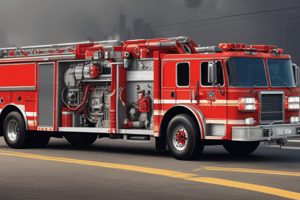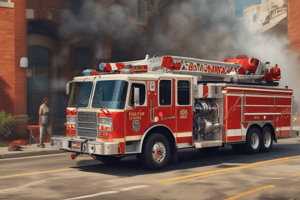Podcast
Questions and Answers
What is the secret to success for managing a taxpayer fire?
What is the secret to success for managing a taxpayer fire?
- Knowing what is likely to happen and having the foresight to take actions to cut it off at the start (correct)
- Relying on traditional firefighting methods
- Focusing solely on the main fire area
- Waiting to assess the situation before acting
How many members are required for effective roof operations in taxpayer fires?
How many members are required for effective roof operations in taxpayer fires?
- Two members with one saw
- Six members with three saws
- Five members with no specific equipment needs
- At least four members with two saws (correct)
What type of operations are particularly demanding at taxpayer fires?
What type of operations are particularly demanding at taxpayer fires?
- Ground-level operations
- Rescue operations
- Water suppression operations
- Truck operations (correct)
Who should be specifically assigned to oversee roof operations?
Who should be specifically assigned to oversee roof operations?
What is the primary reason for sending a truck with personnel to a fire scene?
What is the primary reason for sending a truck with personnel to a fire scene?
Why is a single 300-gpm handline preferred over two 150-gpm lines in certain situations?
Why is a single 300-gpm handline preferred over two 150-gpm lines in certain situations?
What is the recommended action when facing insufficient resources in combating a fire in a large structure?
What is the recommended action when facing insufficient resources in combating a fire in a large structure?
Why is a 300-gpm handline considered more effective than two 150-gpm handlines?
Why is a 300-gpm handline considered more effective than two 150-gpm handlines?
In what type of area are large handlines especially advantageous?
In what type of area are large handlines especially advantageous?
What is a key consideration for a fire officer when devising a strategy for tackling a fire?
What is a key consideration for a fire officer when devising a strategy for tackling a fire?
What can happen if resources are not deployed quickly in a fire scenario?
What can happen if resources are not deployed quickly in a fire scenario?
Flashcards
Taxpayer fire success secret
Taxpayer fire success secret
Knowing what will happen and preventing it at the beginning.
Minimum roof ops crew
Minimum roof ops crew
At least four firefighters with 2 saws.
Most demanding operations
Most demanding operations
Truck operations are more demanding than other operations.
Who oversees the roof?
Who oversees the roof?
Signup and view all the flashcards
Why send a truck?
Why send a truck?
Signup and view all the flashcards
Why one 300-gpm handline?
Why one 300-gpm handline?
Signup and view all the flashcards
Response to insufficient resources
Response to insufficient resources
Signup and view all the flashcards
300-gpm handline advantage
300-gpm handline advantage
Signup and view all the flashcards
When to use large handlines
When to use large handlines
Signup and view all the flashcards
Fire officer's main responsibility
Fire officer's main responsibility
Signup and view all the flashcards
Delayed resource deployment consequence
Delayed resource deployment consequence
Signup and view all the flashcards
Study Notes
Taxpayer Fires
- Success in taxpayer fires relies on foresight and proactive measures to prevent escalation.
- Operate under the principle that catching up to a fire is often not feasible; advance immediately to mitigate risks.
- Operations in taxpayer fires are personnel-intensive due to remote working areas.
- Roof operations require a minimum of four personnel equipped with two saws, four hooks, two axes, and two Halligan tools for timely vent hole creation.
- Assign an experienced officer as the roof sector commander to oversee operations.
Fighting Fires in Large Structures
- Fires in large structures typically necessitate deploying at least three lines along with extra truck personnel for tasks like forced entry and ceiling pulls.
- Immediate availability of resources to operate lines is critical; lacking this could compromise the operation before it even starts.
- Recognize potential issues early and request additional resources promptly; unnecessary units can be dismissed later.
- A single 300-gpm handline outperforms two 150-gpm lines due to enhanced reach and penetration capabilities, making it particularly effective in larger spaces.
- Large, open-floor areas facilitate the advancement of large handlines; smaller lines are preferred in residential environments.
- No universally applicable solution exists for fire incidents; the fire officer must craft a unique strategy tailored to each scenario.
Studying That Suits You
Use AI to generate personalized quizzes and flashcards to suit your learning preferences.




